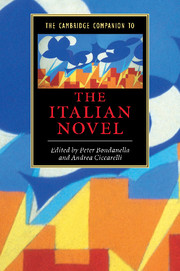Book contents
- Frontmatter
- 1 The belated development of a theory of the novel in Italian literary culture
- 2 The forms of long prose fiction in late medieval and early modern Italian literature
- 3 Alessandro Manzoni and developments in the historical novel
- 4 Literary realism in Italy
- 5 Popular fiction between Italian Unification and World War I
- 6 The foundations of Italian modernism
- 7 Neorealist narrative
- 8 Memory and testimony in Primo Levi and Giorgio Bassani
- 9 The Italian novel in search of identity
- 10 Feminist writing in the twentieth century
- 11 Italo Calvino and Umberto Eco
- 12 Literary cineastes
- 13 Frontier, exile, and migration in the contemporary Italian novel
- 14 The new Italian novel
- Index
- Series List
2 - The forms of long prose fiction in late medieval and early modern Italian literature
Published online by Cambridge University Press: 28 May 2006
- Frontmatter
- 1 The belated development of a theory of the novel in Italian literary culture
- 2 The forms of long prose fiction in late medieval and early modern Italian literature
- 3 Alessandro Manzoni and developments in the historical novel
- 4 Literary realism in Italy
- 5 Popular fiction between Italian Unification and World War I
- 6 The foundations of Italian modernism
- 7 Neorealist narrative
- 8 Memory and testimony in Primo Levi and Giorgio Bassani
- 9 The Italian novel in search of identity
- 10 Feminist writing in the twentieth century
- 11 Italo Calvino and Umberto Eco
- 12 Literary cineastes
- 13 Frontier, exile, and migration in the contemporary Italian novel
- 14 The new Italian novel
- Index
- Series List
Summary
An overview of the early Italian novel might well begin with the observation that Italian writers never felt too comfortable with the novel as a literary form before the nineteenth century. Therefore, many literary historians came to the inevitable conclusion that the birth of the Italian novel takes place in 1827 with Alessandro Manzoni's I promessi sposi. Such an assessment makes sense only if it implies that detecting a unified pattern of development in the Italian premodern novel leading to the “rise” of the “modern” novel would be very difficult. To put it another way, the Renaissance Boccaccian novella does not “evolve” into the bourgeois novel of the eighteenth century. In the Italian canon, there is no Astrée after Sannazaro's Arcadia, and the historical novel of the seventeenth century does not constitute an antecedent of the early nineteenth-century historical novel. Yet so vast a literary output cannot fail to stimulate the curiosity of the reader interested in the history of the genre and in the relationship between literature and the society that produced it.
The fourteenth century
Giovanni Boccaccio is generally considered to be the founder of modern narrative as it emerged in postmedieval Europe. He stands out in the history of modern European culture as a reviver of the literary tradition, of the pastoral allegory and biography as well as the various forms of fiction: the novella, the longer narrative poem, and long prose fiction. Just as his friend Francesco Petrarca created the language of the new lyric, so Boccaccio, gathering up the entangled but vigorous threads of the medieval tale and novel, established the types and prose style of European narrative.
- Type
- Chapter
- Information
- The Cambridge Companion to the Italian Novel , pp. 20 - 41Publisher: Cambridge University PressPrint publication year: 2003



